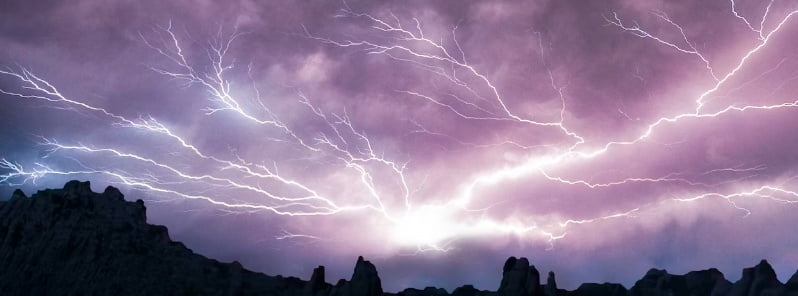Lightning strikes in European eastern Alps doubled over the past 40 years

A team of researchers from the Departments of Geosciences, Atmospheric Sciences, and Statistics at Innsbruck has reported a doubling in the number of detected lightning strikes in the high altitudes of the European Eastern Alps over the last 40 years.
The Innsbruck team, including atmospheric and statistical scientists Thorsten Simon, Georg Mayr, Deborah Morgenstern, Nikolaus Umlauf, and Achim Zeileis, reconstructed the lightning activity of cloud-to-ground lightning in the area of the European Eastern Alps from 1980 to 2019 with unprecedented precision. They used a special combination of extensive data sets for this study, which was published in the journal Climate Dynamics.
“In this study, we link two sources of information, both available at a spatio-temporal resolution of 32 km x 32 km and one hour. From these datasets we obtain, on the one hand, information on lightning activity with seamless records over the last decade. On the other hand, we access analyses of atmospheric conditions—including cloud microphysics—at an hourly resolution over the past four decades,” Simson explained.
The researchers found that mountainous areas, due to their topography, have favorable conditions for the development of thunderstorms. “Our analyses over this terrain have now shown that the rising temperatures due to climate change are causing the frequency of thunderstorms and thus lightning to increase even further. The fact that this trend is so clearly in line with global changes in the climate system also surprised us,” Simon says.
According to the Innsbruck scientists, the most intensive changes occurred in the high Alps between 1980 and 2019. “There, lightning activity doubled in the 2010s compared to the 1980s. In the high-altitude areas of the Eastern Alps, the lightning season reaches a stronger maximum and starts a month earlier. During the day, the peak is up to 50% stronger, with more lightning in the afternoon and evening.”
The researchers’ comprehensive examination of different processes over the complex terrain of the Alps contributes significantly to understanding the relationships between weather, climate, and lightning activity.
“This is important not least for the appropriate development of preventive measures to protect people and the environment from the potential damage caused by lightning strikes,” Simon said.
References:
1 Alps: Lightning activity doubled in a few decades – University of Innsbruck – June 20, 2023
2 Amplification of annual and diurnal cycles of alpine lightning – Thorsten Simon et al. – Climate Dynamics – April 27, 2023 – https://doi.org/10.1007/s00382-023-06786-8
Featured image credit: Micah Tindell

Commenting rules and guidelines
We value the thoughts and opinions of our readers and welcome healthy discussions on our website. In order to maintain a respectful and positive community, we ask that all commenters follow these rules.